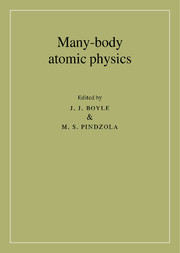Book contents
- Front Matter
- Contents
- Foreword
- Contributors
- Preface
- Acknowledgements
- Part 1 ATOMIC STRUCTURE
- Part 2 PHOTOIONIZATION OF ATOMS
- Part 3 ATOMIC SCATTERING: A. General Considerations
- Part 3 ATOMIC SCATTERING: B. Low-order applications
- Part 3 ATOMIC SCATTERING: C. All-order applications
- Appendix: Units and notation
- References
- Index
Preface
Published online by Cambridge University Press: 22 September 2009
- Front Matter
- Contents
- Foreword
- Contributors
- Preface
- Acknowledgements
- Part 1 ATOMIC STRUCTURE
- Part 2 PHOTOIONIZATION OF ATOMS
- Part 3 ATOMIC SCATTERING: A. General Considerations
- Part 3 ATOMIC SCATTERING: B. Low-order applications
- Part 3 ATOMIC SCATTERING: C. All-order applications
- Appendix: Units and notation
- References
- Index
Summary
Hugh Padraic Kelly is generally recognized by the scientific community as a pioneer in the application of diagrammatic many-body perturbation theory to problems in atomic physics. His work began in the late 1950's and early 1960's with the study of correlation energies in light atoms. From that time, with numerous colleagues and students, he led the development of many-body methods for the treatment of a wide variety of problems in atomic structure, photoionization of atoms, and electron-scattering from atoms. On April 15–17, 1993, some of the leading atomic theorists in the world attended a workshop at the Institute for Theoretical Atomic and Molecular physics at the Harvard-Smithsonian Center for Astrophysics in order to review the application of many-body theory to atomic physics in memory of Hugh Kelly. The organizers of the workshop took advantage of this setting in order to ask the participants to contribute chapters for a textbook on theoretical many-body atomic physics – one that would promote the field to prospective students, as well as would pay tribute to the memory of the field's pioneer. This book is the result of that effort.
This book can be used as a supplement to seminar courses in atomic physics, many-body physics, or quantum chemistry. Each chapter is self-contained and there are cross references between the chapters. Where possible, consistent notation is used in the the various chapters and a key to this notation is included in the Appendix.
There are three main topics with a total of fifteen chapters.
- Type
- Chapter
- Information
- Many-Body Atomic Physics , pp. xvii - xxPublisher: Cambridge University PressPrint publication year: 1998



